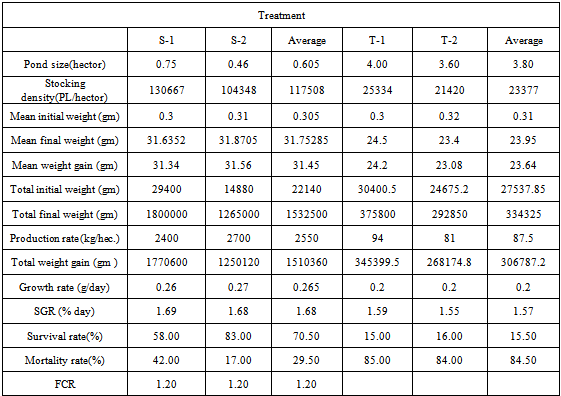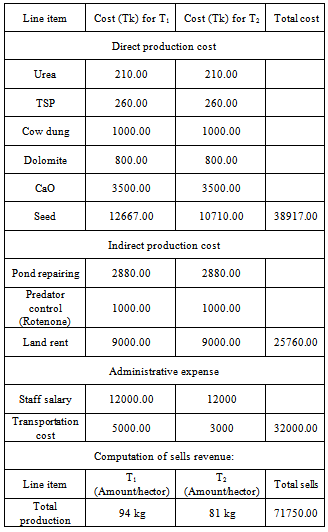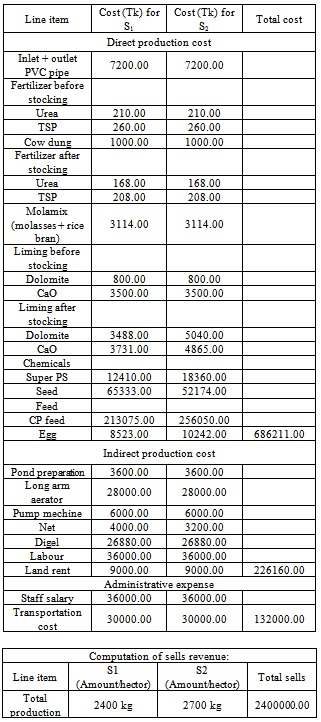-
Paper Information
- Next Paper
- Paper Submission
-
Journal Information
- About This Journal
- Editorial Board
- Current Issue
- Archive
- Author Guidelines
- Contact Us
Science and Technology
p-ISSN: 2163-2669 e-ISSN: 2163-2677
2013; 3(1): 1-16
doi:10.5923/j.scit.20130301.01
Comparative Study on Growth Performance of Bagda (P. monodon, Fabricius, 1798) in Traditional and Semi-intensive Culture Systems
Partho Pratim debnath 1, Manjurul Karim 2, Quazi A. Z. M. Kudrat-E-Kabir 3
1Laboratory Manager, The WorldFish Center Cox’s Bazar, Bangladesh
2Deputy Chief of Party, The WorldFish Center, Khulna, Bangladesh
3Project Manager, The WorldFish Center, Khulna, Bangladesh
Correspondence to: Partho Pratim debnath , Laboratory Manager, The WorldFish Center Cox’s Bazar, Bangladesh.
| Email: |  |
Copyright © 2012 Scientific & Academic Publishing. All Rights Reserved.
A comparative study of growth performance of giant tiger shrimp, Penaeus monodon from two traditional and two semi-intensive culture systems was conducted from 14th March to 16th July, 2008 in the village Pania under Kaligonj Upazila of Satkhira district in order to observe the following attributes: stocking density, growth, growth rate, survival rate, production, production rate, production cost, net profit, gross profit and water quality parameters. The average size of the pond in traditional and semi –intensive culture system was 3.80 hector and 0.605 hector respectively. The initial average body weight of shrimp post larvae during stocking was 0.31g and 0.305g in traditional and semi-intensive ponds. During harvest the final average body weight was found 23.95g and 31.75g respectively in traditional and semi-intensive ponds. No nursing was observed either in traditional or semi-intensive ponds. However, fertilizers and supplementary feed were used in semi-intensive culture system after stocking. The pond’s dike system was found stronger in semi-intensive ponds than traditional ponds. The average stocking density of PL in semi-intensive and traditional ponds were 117508 PL/hector and 23377 PL/hector respectively. No apparent variations of water quality parameters were observed in traditional and semi-intensive ponds through out the culture period. Throughout the culture period, the average growth rate was found 0.265 g/day and 0.2 g/day in semi-intensive and traditional culture systems respectively. The average net profit was estimated-12463.5 BDT/hector and 677814.5 BDT/hector in traditional and semi-intensive culture systems respectively. From the above study it is understood semi-intensive culture system is said to be economically, more profitable and feasible than that of the traditional culture system in terms of growth, growth rate, gross and net profit.
Keywords: Shrimp, Semi-intensive, Traditional, Post-larvae, Growth, Production, Stocking density
Cite this paper: Partho Pratim debnath , Manjurul Karim , Quazi A. Z. M. Kudrat-E-Kabir , Comparative Study on Growth Performance of Bagda (P. monodon, Fabricius, 1798) in Traditional and Semi-intensive Culture Systems, Science and Technology, Vol. 3 No. 1, 2013, pp. 1-16. doi: 10.5923/j.scit.20130301.01.
Article Outline
1. Introduction
- Bangladesh is an agro-based and riverine country where the fisheries resources play a vital role in the socio - economic development of the country. Fisheries sectors provide fulltime employment about 1.2 million and part time employment facilities to about 10.8 million people [1].The fisheries resources contribute 63% of the national animal protein intake, about 5.24% of the total GDP (gross domestic product) and 4.76% of the total foreign earning majority of which, comes from exporting of shrimp.In the last three decades, shrimp farming has been transformed from a subsistence activity into a large-scale industry producing 30% of world shrimp supply and generating a retail trade of $US 6 billion per year (World Shrimp Farming 2003). Shrimp farming traces its origin to Southeast Asia where for centuries farmers raised incidental crops of wild shrimp in tidal fishponds. Modern shrimp farming was born in the 1930s when Motosaku Fujinaga, a graduate of Tokyo University, succeeded in spawning the kuruma shrimp (Penaeus japonicus). Dr.Fujinaga cultured larvae through to market size in the laboratory and succeeded in mass producing them on a commercial scale. For more than 40 years, he generously shared his findings and published a number of papers on his works. The global shrimp industry has experienced phenomenal growth over the last twenty-two years generating more than 730,000 metric tons of farm cultured product annually. In Bangladesh Shrimp farming already consumes more than 141352.54 hectares of land and is suffering from unprecedented environmental pressure to clean up its damaging methodology. Production increases in shrimp farming over the past ten years have been primarily due to tremendous increases in pond area rather than increased output per land area. Further expansion and productivity gains will most likely result from intensification brought about through improvements in nutrition and breeding programs. In light of the above subject matter, the present study was conducted to make comparison between traditional and semi-intensive culture systems of giant tiger shrimp locally known as Bagda. The giant tiger shrimp, cultured throughout Asia, has always represented more than fifty percent of world production of farmed shrimp, with the western white shrimp (P. vannamei), which represents close to 100% of production in the Western Hemisphere, coming in second. The black tiger shrimp, P. monodon locally known as “Bagda” is one of the largest penaeid shrimps reaching 260 mm in body length and 250 g in weight[2]. It is the most important shrimp in the world[2]. P. monodon is the most important cultivable species among the penaeids. It takes only 3-5 months to reach a body weight of 35g[3]. P. monodon is omnivorous that needs only cheap food with a low production cost. Typical survival rates are 80-95%, with a survival rate of 95%, production cost are merely half those of similar species, with 50% survival[3]. Relatively simple facilities such as low cost clay bottom ponds are suitable for grow out, and even give better results than cement bottom ponds[3]. It is rather hardy and resistant to diseases with only a few cases reported for this prawn[4]. Due to this unique feature, culture practice of this species has been increasing day by day in tropical and subtropical countries of the world[3].The production of marine shrimp in impoundments, ponds, raceways and tanks, got started in the early 1970s, and, today, over fifty countries have shrimp culture activities. In the Eastern Hemisphere, Thailand, Vietnam, Indonesia, India and China are the leaders, and Malaysia, Taiwan, Bangladesh, Sri Lanka, The Philippines, Australia and Myanmar (Burma) have large industries. In the Western Hemisphere, Mexico, Belize, Ecuador and Brazil are the leading producers, and there are shrimp farms in Honduras, Panama, Colombia, Guatemala, Venezuela, Nicaragua and Peru. The shrimp importing nations as the United States, Western Europe and Japan—specialize in high-tech "intensive" shrimp farming, but, thus far, their total production has been insignificant. In the Middle East, Saudi Arabia and Iran produce the most farmed shrimp. At present about 150000 hectare of coastal land are under shrimp cultivation in the Bangladesh[5]. Bagherhat and Khulna districts are the most productive zone for Bagda (P. monodon) culture. Most of the ghers are almost traditionally, collect the fry from the natural sources and rear them in the ghers. As a result, production is 250-273 kg/ha. Where as production rate exceeds 1500-3000 kg/ha in some country[6].Total production of shrimp was 30209 metric tons in 2001-02. About 1447.8 corers taka was earned from frozen shrimp products in 2001-02[1]. Bangladesh seafood export earnings were US$ 356 million in 1999-2000. Of this, US$ 322.5 million came from frozen shrimp alone. This accounted for 6.28% of the total export earnings. The black tiger shrimp (P. monodon) has very high demand in domestic and international markets the important data from developing countries show that shrimp import expanded from 5 billion$ to 7 billion$ and in the next 5 years it will be 10 billion$. The main importers of frozen shrimp from Bangladesh are the United States, closely followed by Japan. The European Union as a group is the largest total importer of shrimp from Bangladesh. It has been estimated that the shrimp culture industry provides direct employment to some 350,000 persons, who are engaged in fry collection and transportation, nursery and grow-out operations, and handling and processing. Women have become involved in removing bottoms of shrimp enclosures, beheading shrimps in shrimp depots and collecting post larvae from the rivers and streams. Women are also engaged in repairing dikes and constructing the shrimp farm. As a result of increases in demand and price, shrimp culture started to expand in the 1970s[7]. Presently, land under shrimp culture has increased to about 141352.54 ha to 52,000 ha estimated at the year 2001-2002[1]. About 75% of this land is located in the Khulna, Bagerhat and Satkhira districts in the south and the rest in the Cox's Bazar district in the south-eastern region of the country. According to some estimates, the area suitable for shrimp culture in Bangladesh is around 0.2 million ha. In Khulna areas, shrimp is cultured in the dry season and paddy in the rainy season and in the Cox's Bazar area, shrimp and salt are produced alternately.Population growth will widen the gap between demand and supply from wild fisheries. Ocean catches have stabilized at approximately 100 million tons per year and future supplies will have to come from aquaculture. Future production growth will most likely shift to intensification wherein output is a consequence of production efficiency per unit area rather than increases in area of production. Efficient use of capital, environmental pressure, and unit cost of administration will mandate earlier return on investment, higher utilization of existing facilities, and reduced exposure to crop failure from accidental loss or disease, and perhaps better food conversion efficiency as the primary rules of operation. Now a days it is proved that, to fulfill the world demand, improved culture technique with genetic improvement could be the only alternatives. The present study was conducted in the shatkhira region to scrutinize the growth performance of P. monodon in traditional and semi-intensive culture systems. Satkhira is situated in the coastal area, near Sundarbans, which offers suitable precondition for shrimp cultivation. It has an area of 4, 12,126 hectare under shrimp cultivation which comprises 30% of the total farming area of Bangladesh[8]. Black tiger shrimp (P. monodon) is the main candidate species of aquaculture in Satkhira region cultured mainly through traditional method. Management techniques are the main aspects in any culture system, which need experimental trials investigation of physico-chemical parameters and knowledge of their effects on the growth of the cultured shrimp for a particular region.Prevailing shrimp culture practice includes: extensive (traditional); extensive (improved); semi-intensive; and intensive systems. Under the traditional system, tidal water carrying shrimp juveniles and finfish is allowed to enter during February to April through the sluice gates of the embankment. The trapped juveniles are allowed to grow for about four months before harvest. After the shrimp are harvested, the land is used for rice cultivation during July to December. Coastal embankments, constructed to increase rice production, adversely affected the natural life cycles of many fish and prawns inhabiting the seas and the estuaries. Extensive shrimp farming (low-density) is conducted in the tropics, in low-lying impoundments along bays and tidal rivers, often in conjunction with herbivorous fish. Impoundments range in size from a few hectares to over a hundred hectares. When local waters are known to have high densities of larval shrimp, the farmer opens the gates, impounds the wild larvae and then grows them to market size. Fishermen also capture wild post-larvae and sell them to extensive farmers for stocking. However, stocking densities are quite low, not over 25,000 post-larvae per hectare. The tides provide a water exchange rate from 0 to 5% per day. Shrimp feed on naturally occurring organisms, which may be encouraged with organic or chemical fertilizer. Construction and operating costs are low and so are the yields. Cast-nets and bamboo traps produce harvests of 50 to 500 kilograms (head-on) per hectare per year. Production costs range from $1.00 to $3.00 per kilogram of live shrimp. Since it is illegal in many countries to build new shrimp farms in tidal and mangrove areas, almost no new extensive shrimp farms are being constructed today. Improved extensive is a superior form over extensive culture system. Where ponds are usually a few ha to 50 ha in size and are normally tidally fed with water. Smaller ponds at higher elevations are sometimes filled with a pump. Two to three juveniles are stocked /m2. Lime and fertilizers are used and feeding is also done, but not systematically. About 50% of the pond water is exchanged during each spring tide cycle or 5–7 cm of water is exchanged every alternate day. Production is usually between 0.6–1.0 Mt/ha/year over two crops.Semi-intensive is another improved form of aquaculture. In this system, 10–35 post-larvae /m2 are stocked in smaller ponds, with sizes ranging from 0.4–5.0 ha. They are given mostly pelleted feed but they also partly subsist on natural foods. The ponds are generally aerated and 10–20% of water is exchanged daily by gravity drainage. Yields of 2–5 Mt/ha/yr are commonly obtained. The fourth one, intensive is the highly scientific culture system organized by a stocking density of 35 post-larvae/m2, pond size ranging from 0.1 ha to 5 ha in size. Water is aerated and at least 30% of pond water is exchanged daily. Shrimp are fed entirely with artificial feed and production is about 5–10 Mt/ha/year. Although almost all of the shrimp farms built in the last few years are semi-intensive and intensive in nature, much of the world's production still comes from extensive farms. India, Vietnam, Bangladesh, the Philippines and Indonesia are good examples of countries with vast areas of extensive farms. Ecuador and Honduras have extensive farms. China pursues its own brand of intensive farming. Japan, Taiwan and the United States concentrate on intensive shrimp farming—and intensive farms occur in all the major shrimp farming areas of the world. During the last twenty years, shrimp culture practices in Bangladesh have changed from traditional to improve traditional and there is increasing emphasis now on semi-intensive systems. Presently most of the shrimp farms in Kaliganj thanna, Satkhira are following traditional type of culture methods which involves no or very little effort in pond preparation, acclimation, nursing of fries, supplementary feeding, predator control and regular water quality monitoring. As a result, the production rate rarely exceeds 150 kg/ha/year, which is far bellow the production rate achieved in other tiger shrimp producing countries in the world[9]. Besides, shrimp farmers face many problems, such as, land use right, land use policy, legal supports, shortage of shrimp fry, infrastructure, industrial credit and marketing facilities. Very recently production of shrimp faced big setback due to viral out-breaks. It is estimated that viral infection causes a loss of world production of US Dollar 2 billion[10]. New diseases are still being found and man become suspicious minded to carry out culture practices of shrimp. It is evident that viral diseases are more susceptive to marine and brackish water shrimps than fresh water prawns [11].In the research world, concerning penaeid shrimp farming, significant effort has been so far paid to the intensification of monoculture of P. monodon in overseas countries[12, 4, 13, 14, 15, 16, 17, 18, 19, 20, 21, 22, 23, 24, 25, 26, 27, 28, 29 and 30]. Effect of various environmental factors on growth and survival of larvae, post larvae, juvenile and adult of P. monodon” has also been studied in various countries[31, 32, 33, 34, 35, 36, 37, 38].[39] Described various culture techniques of shrimp in Japan. In a series of reports[40, 41, 42, 43] described the nutritional aspects of shrimp and effects of dietary supplements on the feeding behaviour of shrimp.[44] Described in detail collection, handling and transportation of shrimp seed.[45] Described about construction of model ponds for shrimp culture.[46, 47] gave valuable suggestion for planning of shrimp farms and pointed out the criteria for intensive shrimp farms.[48, 49] described nutritional aspect of P. monodon and water quality management for intensive shrimp culture.[50] described extensive and semi-intensive shrimp culture practiced in the Philippines.[51] pointed out important criteria for selecting healthy post larvae for stocking into ponds.[52] gave an idea of economic evaluation of the extensive, modified extensive, semi - intensive and intensive systems of shrimp culture in the Philippines.[53] described the status and prospects of shrimp industry in the Philippines.[54] discussed shrimp health in aquaculture.[55] described typical shrimp diseases, their causes, prevention and control measures.[56] discussed the various management techniques of P. monodon under extensive and semi-intensive system.In Bangladesh, a few studies have so far been made to evaluate the growth, survival and production of P. monodon under the semi-intensive and other culture system with formulated pelleted feed and higher densities in coastal brackish water ponds.[57] observed some physico-chemical parameters of tide-fed shrimp ponds.[58] studied the limnology of experimental shrimp ponds in Chandpur. The effect of stocking densities on the growth, survival and production of black tiger shrimp in brackish water ponds was studied by[59].[9] studied the production rate of P. monodon using various densities and supplemental feed in brackish water ponds at Paikgacha, Khulna.[60] carried out semi-intensive culture of Bagda during winter season in Cox’s Bazar.[61] also studied production rate of Bagda in brackish water ponds of Bangladesh.[9] studied the effect of acclimatization periods on survival of transported Bagda fries. The food and feeding habit of the species has been studied by [62]. The length-weight relationship of the species has been studied by [63]. The present study has been carried out to compare the growth performance of Bagda (P. monodon) between traditional and semi-intensive culture methods that widely practiced at Kaliganj in Satkhira district with the following objectives:● To know the growth performance in traditional and semi-intensive culture systems.● To know the economic feasibility of two culture methods ● To know the effect of stocking density on growth, survival and production in different culture methods.● To know the effect of physcio-chemical parameters on growth and survival of cultured shrimp in two different management systems.
2. Materials and Methods
2.1. Selection of the Study Area
- The survey was conducted in the village Pania under Kaliganj Upazila of Satkhira District. Two traditional (T1 and T2) and two semi-intensive (S1 and S2) cultured ponds were used in the present study. The water surface areas of the two traditional ponds T1 and T2 were 4.0 and 3.6 hector respectively and two semi-intensive ponds S1 and S2 were 0.75, and 0.46 hector respectively.
2.2. Study Period
- The study was conducted from 14th March 2008 to 16th July 2008.
2.3. Data Collection
- Various physical conditions of the ponds such as types of soil, gher dike, depth of water, color of the water, presence or absence of aquatic weed, etc. were collected at the beginning of the study for once. Physico-chemical parameters of the ghers such as pH, alkalinity (mg CaCo3 / L) and DO (ppm.) were measured using chemical kits [NASA chemical kit, CP Aquaculture (India) Pvt. Limited] whereas salinity (ppt.) were determined by using refractometer ( Model: ref 201) and temperature was measured by using thermometer at every seven days interval. At the same time the average body weight (gm) 2.5% shrimp were measured using a digital weight machine (Model: fej-200). Samples of shrimps were collected from 4 to 5 selected spots using a cast net and the samples were kept in a plastic bucket which was washed by potassium permanganate as an anti-septic. Data related too shrimp culture and productivity including pond preparation procedure, fry stocking and post stocking management including liming, fertilization, supplementary feeding and production were collected from farmer’s record book.
2.4. Semi-Intensive Culture System
2.4.1. Inlet and Pumping System
- There was an inlet in the middle of the reservoir in front of the source of river water. There was also a pump machine for collecting water for reservoir from the river. Inlet was prepared to obtain the best quality of incoming water.
2.4.2. Reservoir
- Two reservoirs were prepared for the farm to supply necessary water in the culture ponds. The area of reservoirs was 0.27 hector and 0 .40 hector.
2.4.3. Aeration
- Square shape ponds were aerated using electrical aerator. Each pond was aerated using two long-arm aerator installed at the opposite corner of the pond and powered by generator. It was operated about 12 hours/day.
2.4.4. Dikes
- Dikes were 0.3m above the maximum water level which was high enough to prevent flooding. Polythene was used along the dike, which continued up to the 1 meter depth of the bottom. Slope of dike was 1: 3 m.
2.4.5. Inlet and outlet
- Both the ponds had inlet and outlet systems.
2.4.6. Buildings
- Two houses were made – one for storing necessary materials and another for the accommodation of workers.
2.4.7. Pond Preparation
- Water of the ponds was removed from the ponds by using pump machine and also black soil was removed from the bottom of the ponds. Then the bottom of the ponds was dried by the sunlight as long as the bottom soil had become cracked. Then ploughing was done by using tractor for two times about one week interval. Entrance of unwanted and fouling organisms was restricted by fencing round the pond. Water was reserved into reservoir from river. After settlement, water was bleached by using bleaching powder into water. After three days dolomite was given at 65kg/hec. After one week water was shifted from reservoir to the ponds.
2.5. Traditional Culture System
2.5.1. Farm Design and Pond Preparation
- There was no specific design followed by the farmer for traditional culture system. Pond preparation was done as usual. At the very beginning of pond preparation the bottom mud was removed by the farmer. The bottom mud was dug with a spade until the undesirable bottom black soil was partially removed. Then dike was repaired to avoid the loss of culturable species. The farmer carried out the repairment of the dikes. The farmer pulled out manually aquatic weeds present in the ghers. The netting controlled the aquatic weeds. In order to control predator, rotenone was used. The main source of water was the tide of the nearby river. In some cases he was used to pump water. The liming rate varied from 15-100 kg/bigha which was spread over the gher bottom including the dike walls. Liming was done during fair weather.
2.6. Stocking Management
2.6.1. Source of fry
- The sources of fry was hatchery which was PCR tested by SSOQ for semi-intensive culture. For traditional culture, sources of fry include both wild source fry and hatchery - produced fry.
2.6.2. Acclimatization
- The fry were carried to the gher in an earthen container called hari. The farmer acclimatized the fry through gradual exchange of transported water with the ghers water. This was done by slowly adding pond water to the container.
2.6.3. Stocking Time
- The farmer stocking shrimp fry in the ghers in the month of March and stocking was done in the morning because shrimp fry were highly sensitive to abrupt changes of water parameters and exposure to sunlight.
2.6.4. Stocking Rate
- For semi-intensive ponds:S1 =130667 PL/hector (14/m2)S2 = 104348 PL/hector (11/m2)For traditional ponds:T1 = 25334 PL/hector (3/m2)T2 = 21419 PL/hector (2/m2)
2.6.5. Stocking of Other Species
- In semi-intensive ghers there was no other species and in traditional ghers , stocking of other species were galda, rui, katla, silver carp, mrigal.
2.6.6. Feed and Feding
- The farmer used CP feed (manufactured and marketed by CP Aquaculture Private Ltd., India) for semi-intensive culture. Farmer mixed 1 egg + 5 g C-Vita + 20 g flour with 1 kg CP feed and feeding frequency was four (6 AM, 11 AM, 5 PM, 10 PM) with a feeding rate prescribed by the feed manufacturer. However, for traditional ghers the farmer didn’t use supplementary feed.
2.7. Post Stocking Management
2.7.1. Sampling
- Sampling was done in weekly interval for measuring body weight of the species and checking water quality parameters in semi-intensive culture ghers. In contrast, no sampling was done in traditional culture ghers.
2.7.2. Fertilization
- Both semi-intensive and traditional culture ghers were fertilized by inorganic fertilizer through out the culture period. Organic fertilizer was used only for traditional culture ghers.
2.7.3. Liming
- During culture period the farmer used dolomite just before the moulting period in his semi-intensive ghers. Liming was often done to prevent algal bloom.
2.7.4. Harvesting
- Harvesting was done at a time in semi-intensive ghers . For this, farmer opened the outlet to remove water of the ghers and set a set-bag-net at the mouth of the outlet. He also used khepla jal.In traditional ghers partial harvesting was done from June to August by using net. At the end of the culture period, farmer carried out complete harvest by draining out the pond and then hand picking the fishes.
2.8. Data Analysis
2.8.1. Growth rate
- Growth rate was determined in terms of weight (g). The growth rate of the shrimp was calculated following [58]:
 Where, W2 = Weight (g) at time T2W1 = Weight (g) at time T1T2 = Date of last samplingT1 = Date of previous samplingHere, T2- T1 = 7 days
Where, W2 = Weight (g) at time T2W1 = Weight (g) at time T1T2 = Date of last samplingT1 = Date of previous samplingHere, T2- T1 = 7 days2.8.2. Survival Rate
- The survival rate was calculated by using the following formula:

2.8.3. FCR (Food Conversion Ratio)
- The food conversion ratio for the semi-intensive ponds was calculated following New (1990) as follows

2.8.4. Specific Growth Rate
 Where, W1 = the initial live body weight (g) at time T1 (day)W2 = the final live body weight (g) at time T2 (day)
Where, W1 = the initial live body weight (g) at time T1 (day)W2 = the final live body weight (g) at time T2 (day)3. Results
3.1. Water Quality Parameters
3.1.1. Water Temperature
- 1). Semi-intensive (S1 and S2) Ponds: The water temperature values were varied between 28℃and 33℃ in all the ponds. The water temperature values were found to fluctuate in all the ponds during the culture period (Figure 1).2). Traditional (T1 and T2) Ponds: The water temperature values were varied between 27℃ and 34℃ in all the ponds. The water temperature values were found to fluctuate in all the ponds during the culture period (Figure 2).
3.1.2. Water Alkalinity
- 1). Semi-intensive (S1 and S2) Ponds: The water alkalinity values were varied between 120mg/L and 190 mg/L in all the ponds. The water alkalinity values were found to fluctuate in all the ponds during the culture period (Figure 3).2). Traditional (T1 and T2) Ponds: The water alkalinity values were varied between 90mg/L and 140 mg/L in all the ponds. The water alkalinity values were found to fluctuate in all the ponds during the culture period (Figure 4).
3.1.3. Salinity
- 1). Semi-intensive (S1 and S2) Ponds: The water salinity was varied between 7 ppt and 14 ppt in all the ponds. The salinity gradually increased from March 24 to May 19, 2005 in all the ponds (Figure 5). There after it started to decline. The fluctuation of salinity values showed different patterns in all the ponds through out the culture period. 2). Traditional (T1 and T2) Ponds: The water salinity was varied between 7 ppt and 18 ppt in all the ponds. The salinity gradually increased from March 24 to May 19, 2005 in all the ponds (Figure 6). There after it started to decline. The fluctuation of salinity values showed different patterns in all the ponds through out the culture period.
3.1.4. pH
- 1). Semi-intensive (S1 and S2) Ponds: The pH values were varied between 8 and 8.2 in all the ponds. The fluctuation of pH values showed different patterns in all the ponds through out the culture period (Figure 7).2). Traditional (T1 and T2) Ponds: The pH values were varied between 7.3 and 8.8 in all the ponds. The fluctuation of pH values showed different patterns in all the ponds through out the culture period (Figure 8).
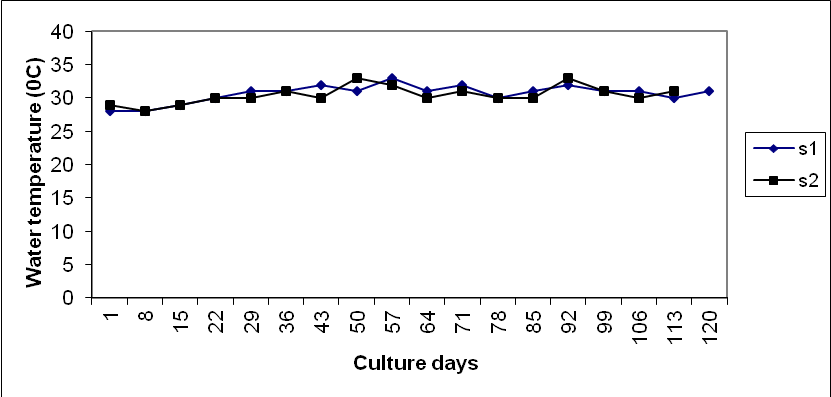 | Figure 1. Weekly water temperature of two semi-intensive ponds |
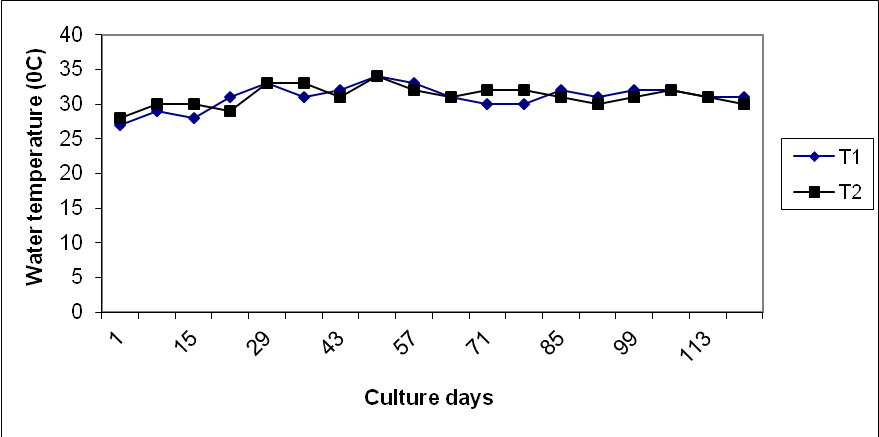 | Figure 2. Weekly water temperature of two traditional ponds |
 | Figure 3. Weekly water alkalinity in two semi-intensive ponds |
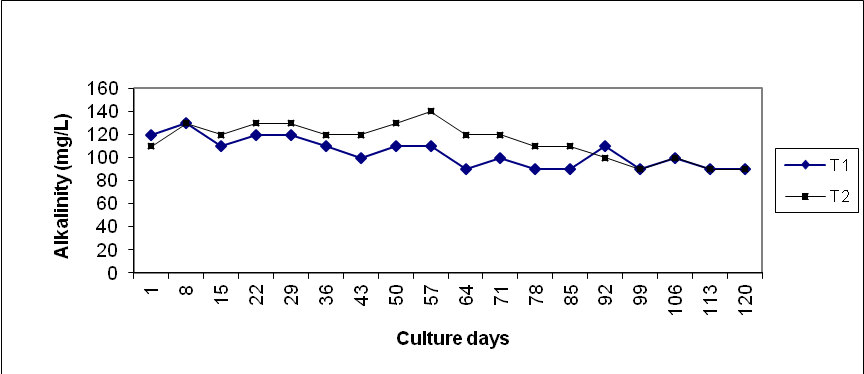 | Figure 4. Weekly water alkalinity in two traditional ponds |
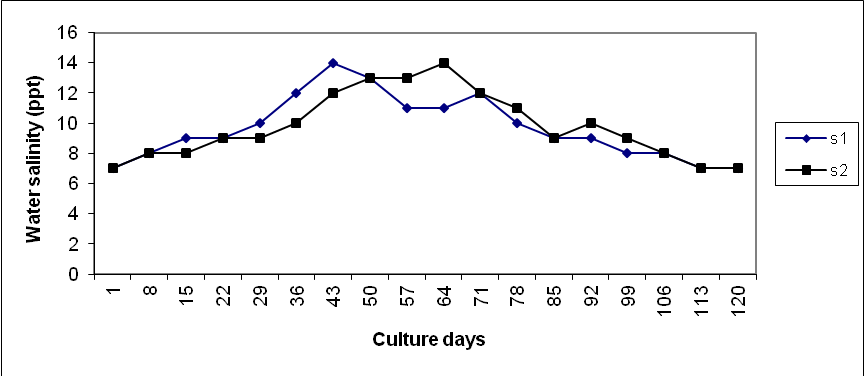 | Figure 5. Weekly water salinity of two semi-intensive ponds |
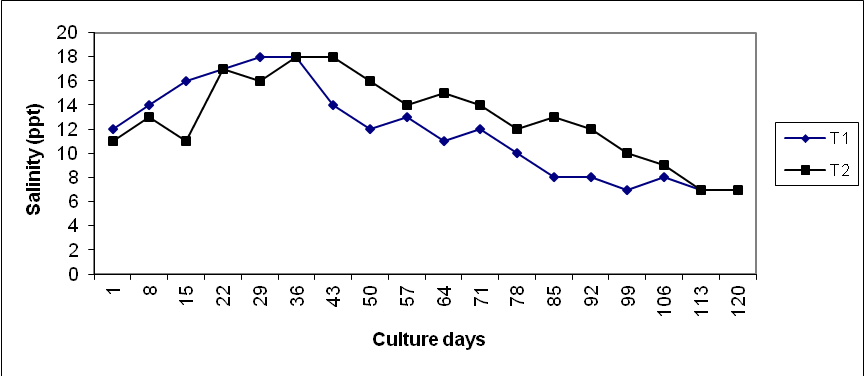 | Figure 6. Weekly water salinity of two traditional ponds |
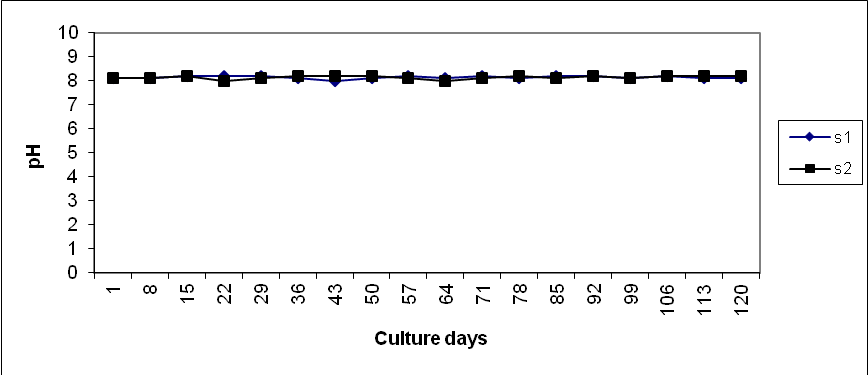 | Figure 7. Weekly water pH of two semi-intensive ponds |
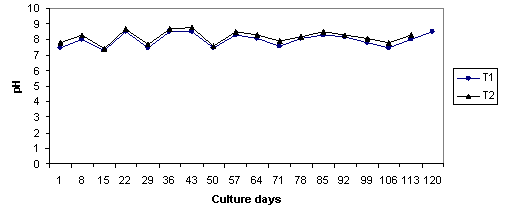 | Figure 8. Weekly water pH of two traditional ponds |
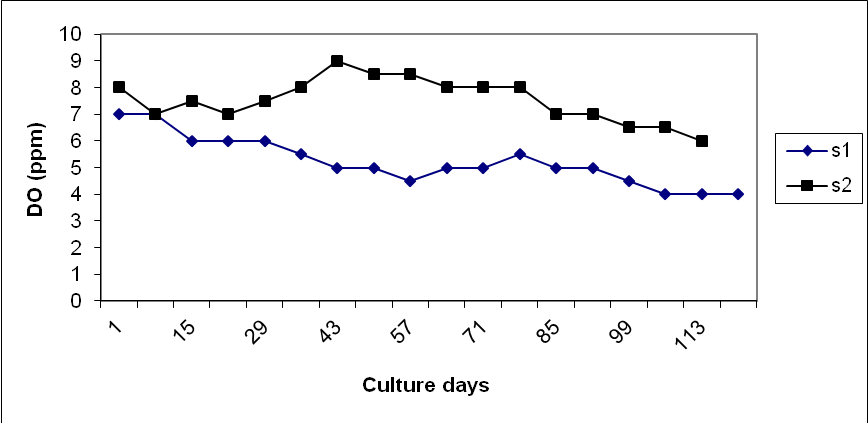 | Figure 9. Weekly water DO of two semi-intensive ponds |
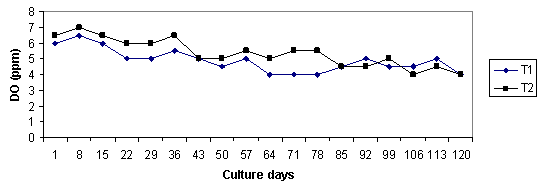 | Figure 10. Weekly water DO of two traditional ponds |
3.1.5. DO
- 1).Semi-intensive (S1 and S2) Ponds: The DO values were varied between 4 ppm and 9 ppm in all the ponds. The fluctuation of DO values showed different patterns in all the ponds through out the culture period (Figure 9).2). Traditional (T1 and T2) Ponds: The DO values were varied between 4 ppm and 7 ppm in all the ponds. The fluctuation of DO values showed different patterns in all the ponds through out the culture period (Figure 10).
3.1.6. Growth
- 1). Semi-intensive (S1 and S2) Ponds: The growth of P. monodon by weight in all the ponds are presented in Figure 11. The growth of P. monodon by weight in all the semi-intensive ponds increased throughout the culture period. The initial average body weight of shrimps in the pond S1 and S2 were 0.3g and 0.31g respectively. After 120 days of culture period the final weight in the pond S1 and S2 were 31.6352g and 31.8705g respectively. The initial overall average body weight was measured 0.305g and the final overall average body weight was measured 31.75285g. Therefore, the overall average absolute growth (Final weight – Initial weight) of the shrimp in semi-intensive ponds was found to be 31.45g.
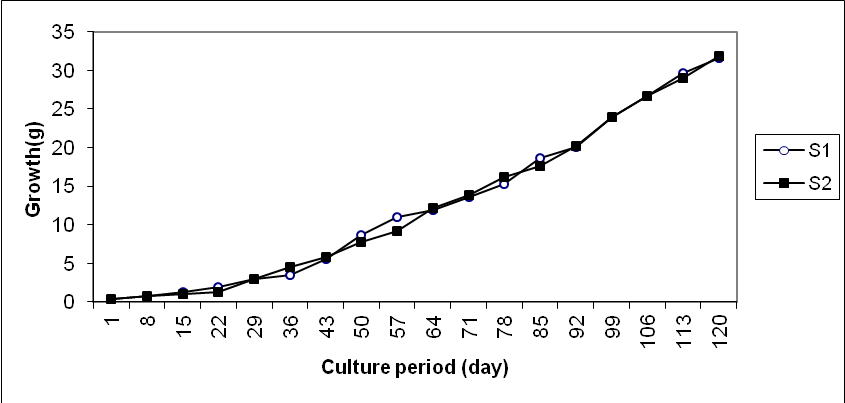 | Figure 11. Weekly growth performance of two semi-intensive ponds |
3.1.7. Survival Rate
- 1). Semi-intensive (S1 and S2) Ponds: The average survival rate of shrimp from two semi-intensive (S1 and S2) ponds was found to be 58% and 83% respectively.2). Traditional (T1 and T2) Ponds:
|
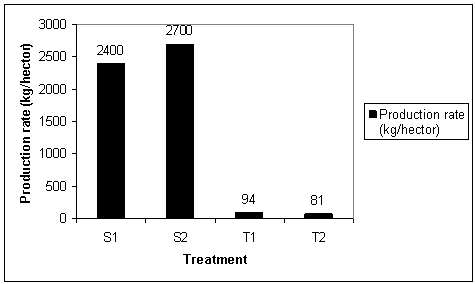 | Figure 12. Production rate (kg/hector) of P. monodon in two semi-intensive (S1 and S2) and two traditional (T1 and T2) ponds |
3.1.8. Production
- 1). Semi-intensive (S1 and S2) Ponds: The total production and production rate of P. monodon in both the semi-intensive ponds are shown in Figure 12. Total production of S1 and S2 were found to be 1800kg and 1265kg with production rate of 2400kg/hector and 2635kg/hector respectively.2). Traditional (T1 and T2) Ponds: The total production and production rate of P. monodon in both the traditional ponds are shown in Figure 13. Total production of T1 and T2 were found to be 375.8 kg and 292.850 kg with production rate of 94kg/hector and 81kg/hector respectively.
3.1.9. FCR (Food Conversion Ratio)
- The final FCR in pond S1 and S2 were found to be 1:1.2 and 1:1.2 and the overall average it was 1:1.2
3.2. Cost-Benefit Analysis
- ● Total operating cost = Direct cost + Indirect cost = 64677.00 Tk.● Gross profit = Total sells revenue – Total operating cost =7073.00 Tk.● Net profit = Gross profit – Administrative cost = -24927● Total operating cost = Direct cost + Indirect cost = 912371.00Tk.● Gross profit = Total sells revenue – Total operating cost =1487629.00 Tk.● Net profit = Gross profit – Administrative cost = 1355629.00 Tk.
|
|
4. Discussion
4.1. Water Quality Parameters
4.1.1. Water Temperature
- Temperature is one of the most important physico - chemical parameters (others are salinity, pH, water transparency and water depth) that have direct effect on the growth of marine shrimp[38].[49] reported that the optimum temperature for P. monodon culture is 25℃ to 32℃.[56] mentioned a range of water temperature from 25℃ to 30℃ would be favorable for P. monodon culture. For penaeid species, recommended range of temperature is about 25℃ to 30℃ [56]. In the present study water temperature was found to fluctuate between 28℃ and 33℃ in traditional ponds and 27℃ to 34℃ in semi-intensive ponds (Table-1).
4.1.2. Salinity
- Fluctuations in salinity below 8 ppt or above 18 ppt have been reported to be retard for growth of penaeid shrimp[28]. The different trends were found for both the culture systems in the present study. The salinity varied from 7 ppt to 18 ppt in traditional and 7 ppt to 14 ppt in semi-intensive ponds, which were favorable for the growth of shrimp (Table-1).[47 and 56] mentioned that the optimum range of salinity for P. monodon farming would be 10 ppt to 25 ppt.[64, 12 and 4] have observed a direct influence of salinity on the growth of P. monodon. Although low and high salinities below 10 ppt and above 25 ppt were reported to retard growth of P. monodon [47, 56].
4.1.3. pH
- The best range of water pH for shrimp culture is 7-9[28]. The pH values in all traditional and semi-intensive ponds in the present study were within this range. [47] Noted that optimum range of pH is 6.8-8.7 for shrimp culture. The pH range in all the traditional and semi-intensive ponds indicated that the water was alkaline with pH ranging from 7.3-8.8 and 8-8.2(Table-1). Low pH reduces ammonia toxicity [65] but mobilizes metals, including iron and aluminum, which can reduce yields in aquaculture ponds [66]. Low pH can also reduce natural pond productivity presumably by reducing the availability of nutrients [67] including phosphorus[68] and carbon sources for photosynthesis, e.g. bicarbonates and hence alkalinity. If the pH is reduced, problem may be encountered with soft shrimp exoskeletons and this could affect marketability [66]. [69] reported that lower and higher pH values occurred due to high rainfall and high abundance of algae respectively. To maintain pH level at optimum range, lime was applied regularly in the semi-intensive ponds. However, no significant difference in pH values in semi-intensive ponds was noticed with traditional ponds.
4.1.4. Alkalinity
- For successful culture of P. monodon alkalinity is recommended to be >80 mg/L[70]. Alkalinity is the buffering capacity of the pond water. The higher the alkalinity, the better the stabilization of the pond system. The CP Aquaculture Pvt. Ltd. recommended the range of alkalinity from 80 mg/L to120 mg/L for shrimp culture. In the present study alkalinity was founding fluctuate between 100-220 mg/l in semi-intensive ponds and 90-140 mg/L in traditional ponds.
4.1.5. DO
- In the present study DO level varied between 4-9 ppm in semi-intensive ponds and 4-7 ppm in traditional ponds whereas[71 and 72] considered 4-8 ppm of DO as favorable range for shrimp culture.[73] considered 4-8 ppm or more to desirable range.[74] suggested that there are long term effects of DO level on the growth of shrimp.
4.1.6. Growth
- Among the traditional ponds, comparatively higher growth by weight was found in pond T1 where among the semi-intensive ponds, higher growth by weight was found in pond S2. The final average growth by weight of P. monodon in the present study after 120 days was 23.95g in traditional pond and 31.75g in semi-intensive pond. The stocking density of PL was 3 PL/m2 in traditional ponds and 13 PL/m2 in semi-intensive ponds. Comparatively a higher growth by weight was found in the semi-intensive ponds (Table-2).[59] for example, found 21.65 ± 0.81g in 120 days with the stocking density of 5PL/m2. In another experiment in brackish water,[9] reported a weight gain of 27.99 ± 2.07g in 105 days with a stocking density of 4PL/m2. While[22] found a final harvesting weight at 19.0g in 105 days with a stocking density of 5 PL/m2 in fresh water ponds. In another experiment in brackish water,[7] reported a weight gain of 32g in 126 days with stocking density of 18PL/m2 and 26g in 112 days with stocking density of 17PL/m2.[3] reported a weight gain of 31.5g and 31.3g in 106 days with a stocking density of 16 PL/m2.
4.1.7. Growth Rate
- The overall growth rate 0.265g/day and 0.20g/day in semi-intensive and traditional ponds respectively (Table-2). 0.18g/day reported by[59]; 0.28g/day by[9]; 0.15g/day by[22]; 0.05g/day by[75]. The comparatively higher growth rate of shrimp in semi-intensive ponds may be due to better feeding and better management than the traditional ponds.
4.2. Production, FCR and Cost Benefit Analysis
4.2.1. Production
- The production rate of P. monodon in traditional pond T1 and T2 was 94kg/hector and 81 kg/hector respectively and semi-intensive pond S1 and S2 was 2400 kg/hector and 2700kg/hector. The present production rate in traditional ponds seems to be lower than the findings of 767.50 kg /hector reported by[22]; 980.50 kg/hector reported by[59]; 420.20 kg/hector by[9] and 554.34 kg/hector by[75]. The present production rate in semi-intensive ponds seems to be satisfactory with the findings of 4008 kg/hector reported by[3]; 3581 kg/hector by[7].
4.2.2. FCR
- The overall average FCR of P. monodon in the present study after 120 days was 1:1.2 in semi-intensive ponds (table-2). It is highly satisfactory when compared with the findings of 1:1.69 and 1:1.78 by[3] in semi-intensive method for the same species.
4.2.3. Cost-Benefit Analysis
- In the present study, it was found net loss from the traditional ponds and a higher benefit was gained from the semi-intensive ponds.
 From the table it is clear that semi-intensive culture system is economically more feasible than that of traditional culture system.
From the table it is clear that semi-intensive culture system is economically more feasible than that of traditional culture system.5. Conclusions
- In the present study it is observed that semi-intensive culture system is better in all aspects of growth and economic feasibility (growth rate, survival rate, production rate, net profit and gross profit) than the traditional culture systems. Production cost in semi-intensive culture system is higher than the traditional culture system, which could be compensated by the total profit. The reason for the higher production rate in the semi-intensive culture system is due to higher stocking rate of PL, use of feed, regular use of lime, fertilizers, chemicals and better pond management practice.The major setbacks of expanding semi-intensive culture system among with the farmers are-● Lack of extensive service from Government and Non-Government organization● Insufficient credits to the farmers. ● A huge fear about outbreak of viral disease with comparatively higher stocking rate of the shrimp PL. To overcome the above-mentioned problemsGovernment and Non-Government agencies should expand their extension services to the rural farmers to make them understand about scientific culture system of shrimp. It is also argent to set up a new micro-credit service system only for shrimp farmers in the costal zone of Bangladesh. The credit system should be easy for the illiterate farmers to get lone within shortage period of time. Research activities on shrimp disease should be given immediate priorities, so those farmers might be taken preventive measurement against the out break of viral diseases. If proper steps are taken to overcome the problems of the farmers, they will get benefit by these, which promote our national economy.
References
| [1] | DoF. 2003. Brief on Department of Fisheries Bangladesh. Department of Fisheries, Ministry of Fisheries and Livestock, Dhaka, Bangladesh. |
| [2] | Wyban, J., 1996. Sustainable development and commercial potential of SPF Penaeus monodon. Book of Abstructs, World Aquaculture 1996, Jan. 29 - Feb. 2, 1996, world Aquaculture society,PP.2-9. |
| [3] | Liao, I.C., 1981. Status and problems of grass prawn culture in Taiwan. Paper presented at the ROC- Japan Symposium on Mericulture, Taipei, Taiwan, R.O.C. PP. 1-35. |
| [4] | Liao, I.C., 1977. A Culture study on grass prawn Penaeus monodon in Taiwan the patterns, the problems and the prospects, J.Fish.Soc.Taiwan, 5:11-29. |
| [5] | Nuruzzaman, A.K.M., 1985. Shrimp culture and management of coastal environment with emphasis on Cox’s Bazar and Satkhira regions, Bangladesh. Proceedings of the workshop on coastal aquaculture and environmental management, Cox’s Bazar, Bangladesh April 25-28,1995. 94p. |
| [6] | FAO, 1997. Review of the state of World Aquaculture. FAO Fisheries Circular no. 886, Review 1. Food and Agriculture Organization of the United Nations, Rome, Italy. |
| [7] | Rahman, M.A., 1990. Effect of some limnological parameters of tiger shrimp Penaeus monodon production under semi-intensive culture. A thesis by Master of Science (Fisheries) in Fisheries Biology and Limnology, Bangladesh Agricultural University, Maymensingh.P.1. |
| [8] | DoF, 1996. Brief on Department of Fisheries Bangladesh. Department of Fisheries, Ministry of Fisheries and Livestock, Dhaka, Bangladesh. |
| [9] | Hoq, M.E., Halder, G.C. and Begum, M., 1994. Experimental pond culture of tiger shrimp, Penaeusmonodon (Fab.) with various stocking rates and supplemental feeding. Progressive Agriculture, 5(2):55-61. |
| [10] | Ahmed, A. T. A., 1995. Disease problem of shrimp in semi-intensive culture farm at Cox’s Bazar area. A keynote presented at the workshop on shrimp disease in semi - intensive farms at Cox’s Bazar, December 1994. PP. 1-4 |
| [11] | Nash, J.L., 1990. Penaeus monodon grow –out disease. Proceedings of the AQUATECH Conference on “Technical and Economic Aspects of Shrimp farming”. Kualalumpur, Malaysia, 11-14 June,1990. PP. 172-190. |
| [12] | Verghese, P.U., Ghosh, A.N. and Das, P.B., 1975. On growth , survival and production of Jambo tiger prawn Penaeus monodon(Fab.) in backish water ponds. Bull. Dept. Mar.Sci.Univ. , 7(4) : 781-789. |
| [13] | Mokizuki, H., 1979. Recent Prawn Culture In The Philippines. Philippine J.Fish., 16:39-125. |
| [14] | Apud. F. D., Gonzales, K. and Deatras, N., 1981. Survival, growth and production of Penaeus monodon(Fab.) at different stocking densities in earthen ponds with flow through system and supplementary feeding. Fisheries Research journal of the Philippines, 6:1-9. |
| [15] | Liu, M.S. and Mancebo, V.J., 1983. Pond culture of Penaeus monodon in the Philippines: Survival, growth and yield using commercially formulated feed. J.World.Maricult. Soc., 14:75-85. |
| [16] | Apud. F. D., 1984. Extensive and Semi-intensive culture of sugpo(Penaeus monodon) in the Philippines. In: Prawn Industry Development in the Philippines. SEAFDEC Aquaculture Department, Iioilo, the Philippines, PP. 55-73. |
| [17] | AQUACOP, 1985. Overview of penaeid culture research: Impact on commercial activity. In Proc. 1st 1nt. Conf. On Penaeid prawns/shrimps, edited by T. Taki, J. H. Primavera and J. A. Lioberaere. S. SEAFDEC- Aquaculture Department: Iioilo, the Philippines, PP. 3-10. |
| [18] | Chiang, P. and Liao, I.C., 1985. The practices of grass prawn (Penaeus monodon) culture in Taiwan from 1968 to 1984. J. World. Maricult. Soc., 16:297-315. |
| [19] | Chiu, Y.N., 1987. Water Qulity management for intensive prawn ponds. In: Technical Consideration for the Management and Operation of Intensive Prawn Farms, edited by Y.N. Chiu, L.M. Santos and R.O. Juliano, U.P. Aquaculture Society, Iioilo, the Philippines, PP. 74-95. |
| [20] | Wyban, J. A., Lee, C.S., Sato, V.T., Seeney, J.M. and Richards, W.K.J.,1987. Effect of stocking density on shrimp growth rate in manure- fertilized ponds. Aquaculture, 61:23-32 |
| [21] | Tacon, A.G.J., 1988. The Nutrition and Feeding of Farmed Fish and Shrimp, Training Manual No. 3: Feeding Method. FAO Field Doc. Project GCP/RLA/ 075/ITA. Field Doc. No. 7 by E. Brasilia, Brazil, 208 PP. |
| [22] | Felix, S. and Sukumaran, N., 1988. Performance of Penaeus indicus and Penaeus monodon under mono and mixed culture system. In: Proceedings of the First Indian Fisheries Forum, edited by M.M. Joseph. Asian Fisheries Society. Indian Branch, Mangalorer, PP. 129-130. |
| [23] | Sandifer, P.A., Hopkins, J.S. and Stokes, A.D., 1988. Intensification of shrimp culture in earthen ponds in South Carolina: progress and prospect. J. World Maricult. Soc., 19:218-226. |
| [24] | Akiyama, D. M. and Chwang, N. L. M., 1989. Shrimp feed requirements and Feed shrimp Farm Management Workshop. American soybean Association, Singapore, PP. 75-82. |
| [25] | Chen, J.C., Liu, P.C., Lin, Y.T. and Lee, C.K., 1989. Highly intensive culture study of tiger prawn (Penaeus monodon) in Taiwan. In: Aquaculture- A Biotechnology in Progress, edited by N. Depauw, E. Jaspers, H. Ackefors and N. Wilkins. European Aquaculture Society, Bretene, Belgium. PP. 1-6. |
| [26] | Boyd, C.E., 1990. Water Quality in Aquaculture Ponds. Alabama Agr. Exp. S. T. A. Auburn University, Auburn, AL., PP. 242. |
| [27] | Kongkeo, H., 1990. Pond management and operation. In: Proc. Aquatech”90 Conf. On Economic Aspect of Shrimp Farming, edited by M.B. New, H.de Saram and T. Singh. Kuala Lumpur, Malaysia. PP. 56-65. |
| [28] | Boyd, C.E. and Fast, A.W., 1992. Pond monitoring and management. In: Marine Shrimp Culture: Principles and Practices, edited by A. W. Fast and L. J. Lester Elsevier, Amsterdam, PP. 497-508. |
| [29] | Jackson, C.J. and Wang, Y., 1996. The relationship between temperature and growth rate of pond – cultured Penaeus monodon . Book of abstracts, World Aquaculture 96, Jan. 29-Feb. 2, 1996, Bangkok, Thailand, World Aquaculture Society, PP. 175-176. |
| [30] | Linsuwan, C., 1996. Intensive shrimp pond management in Asia. Book of Abstracts, world Aquaculture “96, Jan. 29-Feb. 2, 1996, Bangkok, Thailand, world Aquaculture Society, PP. 229. |
| [31] | Zein-Eldin, Z.P., 1963. Effect of salinity on growth of post larval penaeid shrimp. Biol. Bull., 125:188-196. |
| [32] | Pantastico, J.B. and Oliveros, E.N., 1980 Acclimatization of Penaeus monodon post larvae to freshwater. Fish Res.J. Philippines,5:33-38. |
| [33] | Gaudy, R. and Slone, L., 1981. Effect of salinity on oxygen consumption in post larvae of the penaeid shrimp, Penaeus monodon and P. stylirostris with out and with acclimatization. Mar. Biol., 65:297-301. |
| [34] | Motoh, H., 1981. Studies on the Fishery Biology of the Giant Tiger Prawn, P.monodon in the Philippines (Technical Report No.7) Aquaculture Department, SEAFDEC, Tigbauan, Iioilo city, Philippines, 128 PP. |
| [35] | Manik, R., Adisukerno, S. and Tiensongrusmee, B., 1979. The effect of high salinity on growth and survival of the giant tiger shrimp under cultivation in the earth pond. Bull. Brackishwater Aquacult. Devel. Centre, 5:351-361. |
| [36] | Chakraborti, R.K., Ravichandran, P., Halder, D.D.,Mandal, S.K. and Sanfui, D., 1985. Same physico-chemical characterstics of Kakdeeip Brakish Water ponds and their influence on the survival, growth and production of Penaeus monodon (Fab.). Indian J. Fish., 32:224-235. |
| [37] | Chu, K.H. and So, B.S.H., 1987. Changes in salinity tolerance during larval development of the shrimp Metapenaeus ensis (De Hann). Asian Mar. Biol., 4:41-48. |
| [38] | Lester, L.J. and Pante, M.J.R., 1992. Penaeid temperature and salinity responses. In: Marine Shrimp Culture: Principles and Practices, edited by A.W. Fast and L.J. Lester. Elsevier, Amsterdam, PP. 515-534. |
| [39] | Shigueno, K., 1975. Shrimp culture in Japan. Assoc. Intern. Tech. Programme, Tokyo, PP. 153. |
| [40] | Deshimaru, O. and Yone, Y., 1978a. Effect of dietary supplements on the feeding behavior of prawn. Nippon Suisan Gakkaishi, 44, 903-906. |
| [41] | Deshimaru, O. and Yone, Y., 1978b. Requirements of prawn for dietary minerals. Nippon Suisan Gakkaishi, 44, 907-910. |
| [42] | Deshimaru, O. and Yone, Y., 1978c. Absorption of labeled calcium 45 Ca by prawn from sae water. Nippon Suisan Gakkaishi, 44, 975-977. |
| [43] | Deshimaru, O. and Yone, Y., 1978d. Effect of dietary carbohydrate source on the growth and feed efficiency and prawn. Nippon Suisan Gakkaishi, 44, 1161-1163. |
| [44] | Aure, R.C., 1988. Collection, holding and transport of prawn post larvae. In: Proceedings of Training Course on Prawn Culture Techniques and Management, |
| [45] | Baldiverona, R.B., 1988. Site selection in fish pond construction. In: Proceedings of Training Course on Prawn Culture Techniques and Management, edited by U. P. Visayas, College of fisheries, Leganes Iioilo, the Philippines, PP. 22. Annon, 1986. Shrimp Culture: Pond Design Operation and Management. Selected pub. No. 2 for commemorating World Food Day. Net Work of Aquaculture Centre in Asia, Bangkok, Thailand, PP. 15-48. |
| [46] | Chiu, Y.N., 1988a. Considerations for Planning Prawn farm projects. In: Technical Consideration for the Management and Operation of Intensive Prawn Farms, edited by Y.N. Chiu, L.M. Santos and R.O. Juliano, U.P. Aquaculture Society, Iioilo city, the Philippines, PP. 7-10. |
| [47] | Chiu, Y.N., 1988b. Site selection for intensive prawn farms. In: Technical Consideration for the Management and Operation of Intensive Prawn Farms, edited by Y.N. Chiu, L.M. Santos and R.O. Juliano, U.P. Aquaculture Society, Iioilo city, the Philippines, PP. 25-28. |
| [48] | Chiu, Y.N., 1988c. Prawn nutrition and feeding. In: Technical Consideration for the Management and Operation of Intensive Prawn Farms, edited by Y.N. Chiu, L.M. Santos and R.O. Juliano, U.P. Aquaculture Society, Iioilo city, the Philippines, PP. 86-101. |
| [49] | Chiu, Y.N., 1988d. . Water Qulity management for intensive prawn ponds. In: Technical Consideration for the Management and Operation of Intensive Prawn Farms, edited by Y.N. Chiu, L.M. Santos and R.O. Juliano, U.P. Aquaculture Society, Iioilo city, the Philippines, PP. 102-125. |
| [50] | Corre, V.L., 1988. Prawn feeding management. In: Proceedings of Training Course on Prawn Culture Techniques and Management, edited by U. P. Visayas, College of fisheries, Leganes Iioilo, the Philippines, PP. 5. |
| [51] | Parado-Estepa, F.D., 1988. Selection, transport and acclimation of prawn fry. In: Technical Consideration for the Management and Operation of Intensive Prawn Farms, edited by Y.N. Chiu, L.M. Santos and R.O. Juliano, U.P. Aquaculture Society, Iioilo city, the Philippines, PP. 81-84. |
| [52] | Posadas, B.C.,1988.Economics analysis of various prawn farming systems. In: Technical Consideration for the Management and Operation of Intensive Prawn Farms, edited by Y.N. Chiu, L.M. Santos and R.O. Juliano, U.P. Aquaculture Society, Iioilo city, the Philippines, PP. 12-24. |
| [53] | Tan, G.R. and Cruz, P.F.S., 1988 Status and Prospects of the Shimp Industry. In: Technical Consideration for the Management and Operation of Intensive Prawn Farms, edited by Y.N. Chiu, L.M. Santos and R.O. Juliano, U.P. Aquaculture Society, Iioilo city, the Philippines, PP. 1-6. |
| [54] | Lio-po, G., 1988. Prawn health in aquaculture. In: Technical Considerations for the Management and Operation of Intensive Prawn Farms, edited by Y.N.Chiu, L.M.Santos and R.O.Juliano. U.P. Aquaculture Society, Iioilo city, the Philippines, PP. 130-133. |
| [55] | Baticados, M.C.L., 1988. Typical prawn disease causes, prevention and treatment. In: Technical Considerations for the Management and Operation of Intensive Prawn Farms, edited by Y.N. Chiu, L.M. Santos and R.O. Juliano, U.P. Aquaculture Socity, Iioilo, the Philippines, PP.134-142. |
| [56] | Apud. F. D., 1989. Recent developments in prawn pond culture. Aquaculture extension pamphlet no. 1, May, 1989. Aquaculture Department, SEAFDEC, Tigbauan, Iioilo, the Philippines, PP. 24. |
| [57] | Hossain, S.M.Z., 1987. Studies on some physico-chemical parameters of tide fed shrimp ponds. Bangladesh J. Fish., 10(2):47-56. |
| [58] | Mahmud, Y., Ahmed, S.U. and Moula, G., 1993. Studies on the limnology of two experimental shrimp ponds at FRI Campus, Chandpur. Bangladesh J. Fish. Sciences, 5(1):65 - 70. |
| [59] | Hossain, S.M.Z., Corre, J.R.B. and Tolcdo, C.E., 1992. Effect of stocking densities on the growth, survival and production of Penaeus monodon (Fabricius). Bangladesh Journal of Zoology, 20(1):35-42. |
| [60] | Islam, K.S., Khan, Y.S.A. and Chowdhury, M.J., 1991. Semi-intensive culture of tiger shrimp Penaeus monodon (Fabricius) during the winter season. Proc. Seventh Nat. Zool. Conf. Bangladesh. PP. 43-49. |
| [61] | Quddus, M.M.A., Sufi, G.B., Kalam, M.A. and Nahar, B.S., 1990.Culture of Bagda Shrimp Penaeus monodon (Fab.) in a brackish water pond. Bangladesh J.Sci.Indstl.Res., 8(2):153-163. |
| [62] | Shafi, M., Quddus, M.M.A. and Kibria, K.G., 1978. Food and feeding habits in respect of length-weight relationship and condition and sex- ratio of shrimp. Bangladesh J. Agr., 3(2):398-408. |
| [63] | Kader, M.A., Bhuiyan, A.L. and Rahman, M.M., 1994. The length-weight relationship and condition of Penaeus monodon (Fab.). Bangladesh J. Fish., 7(12):70-80. |
| [64] | Subrahmanyan, M., 1973. Experimental studies on growth in Penaeus monodon(Fabricius). Proc. Seminar on Mariculture and Mechanized Fishing. PP. 70-73. |
| [65] | Whitfield, M., 1974. The hydrolysis of ammonium ions in sea water a theoretical study. J.Mar. Biol. Assoc. Uk. 54:565-580 |
| [66] | Simpson, H.J., Ducklow, H.W., Deck, B. and Cook, H.L., 1983. Brackish water aquaculture in pyrite-bearing tropical soils. Aquaculture, 34:333-350. |
| [67] | Alabaster, J. S. and Lioyd, R., 1980. Water Quality Criteria for Freshwater Fish. Butterworths, London, 297 PP. |
| [68] | Boyd, C.E., 1982. Water Quality Management for Warm water fish Culture. Developments in Aquaculture and Fisheries Science, Vol. 9 Elsevier, Amsterdam, PP. 318. |
| [69] | Nagarajaiah, C.S. and Gupta, T.R.C.,1983. Physico-chemical characteristics of brackish water ponds along Nethravati Estuary, Mangalore, Indian Journal of Marine Sciences, 12:81-84. |
| [70] | Hansell, J., 1993. Health Management in Shrimp Ponds. Aquatic Animal Health Research Institute, Department of Fisheries, Kasetsart University Campus, Jatujak, Bangkok, Thailand. 2 PP. |
| [71] | Pakrasi, B.B., 1978. Ecology of brackishwater ponds. In: Training in Brackishwater prawn and fish farming, held at Kakdwip Res. Cen., Aug. 1-Sept. 30: 13-16. |
| [72] | Banerjea, S.M., 1967. Water quality and soil condition of fish ponds in some state of India in relation to fish production. Ind. J. Fish., 14: 114-144. |
| [73] | Singh,S.P., 1984. Site selection: Soil quality considerations in the selection of sites for aquaculture farms. Aqua-Train/NACA/84-036, 19 PP. |
| [74] | Law, A.T., 1988. Water quality requirements for Penaeus monodon culture. Proc. Sem. Marine Prawn Farming in Malaysia, Serdang, Malaysian Fisheries Society. 53-65. |
| [75] | Biswas, A.K., 1996. Experimental Monoculture of Penaeus monodon Penaeus monodon (Fabricius, 1879) in freshwater ponds at beel kodalia, Mollahat, Bagerhat. A thesis by Bachelor of Science in Fisheries and Marine Resource Technology, Khulna University. PP. 28. |
 Abstract
Abstract Reference
Reference Full-Text PDF
Full-Text PDF Full-text HTML
Full-text HTML